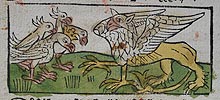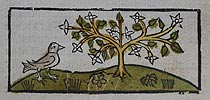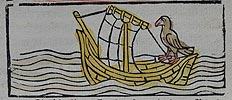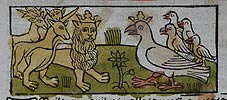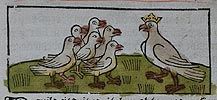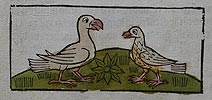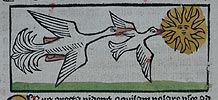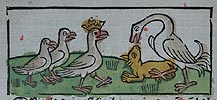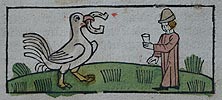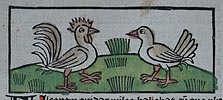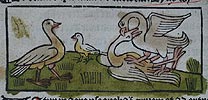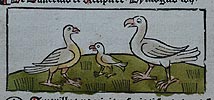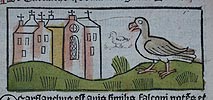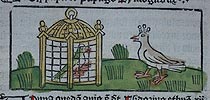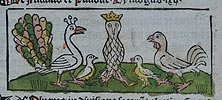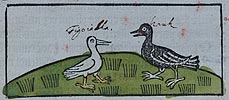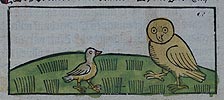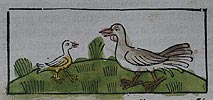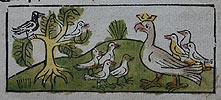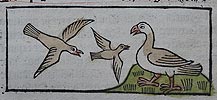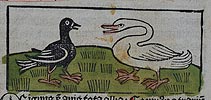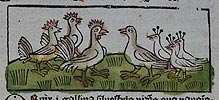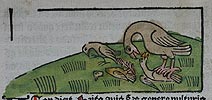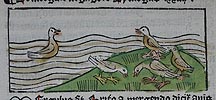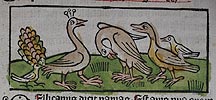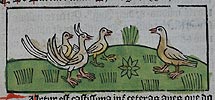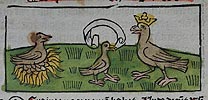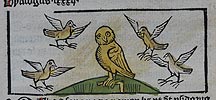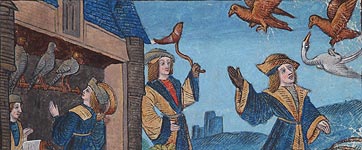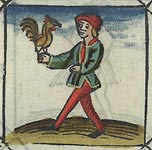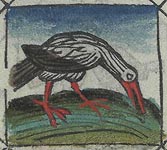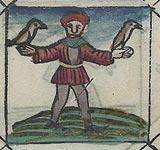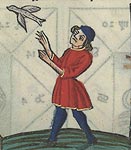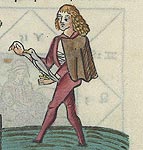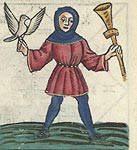Birds Images in Incunabula
- From Aesop to the Bible
- Philosophical Fables
Popular in the Middle Ages became a book of ancient Indian philosophical fables, in which birds are ones of the characters. The fables are attributed to Brahmin Vishnu Sharma who has composed the Panchatantra collection of moralizing stories in order to teach a certain Raja to wisely govern the country.
The Panchatantra consists of five didactic stories that features animals with human qualities, morals and manners to illustrate principles of human society. One of the five stories entitled «The Legend of the War between Crows and Owls» is narrated by the jackals Karataka and Damanaka. In the middle of the eighth century, there appeared the Arabic translation of the «Panchatantra» entitled «Kalila and Dimna»: the two jackals - storytellers' names transmogrified into Kalila and Dimna. Under this title, it became famous in the entire Middle East.
In the thirteenth century, the Arabic version was translated into Spanish by unknown author and into Hebrew by Rabbi Ioel. In the same century (between 1262 and 1269), John of Capua translated the Jewish text into Latin, calling it Directorium humanae vitae alias Parabolae antiquorum sapientium («A Manual of a Human Life or the Fables of the Ancient Wisdom» ). This Latin translation formed the basis for German, Spanish and Italian versions. In Byzantium and later in the Slavic countries, the «Kalila and Dimna», ie «Panchatantra», was known as the «Stefanit and Ihnilat».
Engraving illustrations to this publication include abstract images of birds - for the author, it is more important to show not the species but the action. Birds are depicted in the scenes with other animals (fish, lions, dogs, deer, snakes). Among the images are traps for catching birds.
The «Dialogues of Creatures» («Dialogus creaturarum») are worth of special notice among the early printed editions of fables at the National Library of Russia. It was the first book ever printed in Sweden: the «Dialogues of Creatures» was printed in Stockholm in 1483 by Johann Snell. The fables were compiled by Mayno de Mayneri (Maynus de Mayneriis, c. 1300-1360), a physician and astrologer, well known in his time.
Numerous engravings - illustrations in the book are primitive in drawing, but in the copy held in the National Library of Russia, they are painted with great taste. A cock, geese, a parrot and an owl are represented among the images of birds. However, in most drawings, the birds lack for individual characteristics.
In medieval books, birds are often shown both in realistic scenes of hunting and symbolic ,in particular, astrological illustrations.
The parchment copy of «The Art of Falconry and Hunting with Hounds» («L’Art de fauconnerie et des chiens de chasse») by Guillaume Tardif, stored in the Faust Study, is executed in the style of so-called "printed manuscripts" - luxury editions which were designed by Parisian printing houses for king and his entourage. The book was published by an unidentified Paris printer in 1493 for the publisher and bookseller Antoine Verard. Decorated by hand, «The Art of Falconry» is compiled using ancient hunting treatises and not only gives an introduction to hunting with birds and hounds, but also provides a variety of information on the selection, breeding and training falcons and greyhounds, about treatment and care for them. The text is printed in "bastard" (a graceful typeface modeled after the Gothic writing of the same name with elements of italics). The engraving on the title page portrays the author handing the manuscript to the customer as well as the royal couple (Charles VIII and Anne of Brittany) who goes hunting, accompanied by a retinue.And even so, despite the presence of some very realistic illustrations depicting birds in incunabula, the main portion of pictures are schematic images showing not characteristics of a bird but simply general features of a species. For instance, examine an image from the illuminated parchment «Astrolabe» («Astrolabium») by Johannes Engel, which entered the Public Library together with the collection of Piotr Sukhtelen and includes a book of dream interpretations (Augsburg, Erhard Ratdolt, 1488).
The next part of this review will narrate about the birds in the books of the 16th-17th centuries, and the third part will present editions of the 18th - first quarter of the 19 centuries.
The bibliographic basis of the second and third part is the Catalogue of the Special Holdings in the Library of the Zoological Institute of the Academy of Sciences of Russia, compiled by K. Yuriev and published in 1994, as well as catalogues and books from the collections of both the Rare Books Department of the National Library of Russia and the Zoological Institute of the Russian Academy of Sciences. This is a joint work of staff of our library and the Zoological Institute.

















